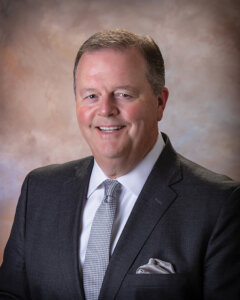
The Paycheck Protection Program (PPP), the $961 billion emergency fund to help businesses stay afloat financially during the COVID-19 pandemic, came to a close in May.
The program launched in March 2020. Some 5,467 lenders across the country processed more than 11.8 million applications totaling nearly $800 billion, according to a May 31, 2021, report by the federal Small Business Administration (SBA), which managed the program.
In Alabama, lenders processed 107,193 loans totaling $3.34 billion.
Today, more than a year since the PPP loan program launched, Alabama lenders reflect on the initiative that they say gave many desperate business customers the boost they needed to keep their doors open and workers on
the payroll.

A Chaotic Start
Gene Crane, executive vice president and business banking manager for River Bank & Trust, which has 18 locations across Alabama, says that after the PPP began last spring, bankers there worked feverishly to process the mountain of loan applications that came in and to meet SBA rules — which the agency revised numerous times over the year.
“From the lender’s perspective, and probably from the borrower’s perspective, too, it was chaotic,” says Crane. “It was stressful. We were all trying to learn a new program and new procedures through the SBA that had never been done before, and, to a great extent, the rules were being written as the program was unfolding.
“That went on for weeks and weeks for us last spring,” he says. “Customers were at a high stress point and feeling the pandemic’s effects on their companies and anxious to get a PPP loan in place. We were trying to meet everybody’s needs and working countless overtime hours to get all that done. But the program delivered to them some capital at a point when a lot of companies were in survival mode.”
Crane says between the first and second round of PPP funding, River Bank & Trust processed approximately 4,500 loans totaling around $200 million.
Meanwhile, Regions Bank, a member of the S&P 500 Index, reported processing more than 75,000 PPP loans totaling more than $6.5 billion in funding to businesses across the South, Regions spokesperson Jeremy King says.

Alan Register, the Birmingham market executive for Regions Bank, says the PPP was a massive undertaking that offered a financial lifeline for small businesses during a period of economic uncertainty unlike anything seen before.
“The outlook is much better today than it was 14 months ago,” says Register. “I believe that, for many business owners, PPP was a crucial piece of the puzzle in making it through the last year.”
As part of the Coronavirus Aid, Relief, and Economic Security (CARES) Act, PPP provided low-interest loans backed 100% by the SBA to help businesses keep workers on the payroll and pay certain expenses during the pandemic. The loans had an interest rate of just 1%.
The loans required no collateral, personal guarantee or fees, and loans issued before June 5, 2020, mature in two years. Those issued after that date mature in five years.
In turn, the SBA paid fees to the lenders on a sliding scale based on the size of each loan processed.
A second round of PPP opened in January 2021 as part of $284 billion Economic Aid Act. The monies were aimed particularly at small businesses that otherwise had limited access to capital.
The deadline for PPP was May 31, 2021, or until the money ran out, but demand for loans was so high that the program ended on May 28 when the SBA notified lenders that the portal would no longer accept new applications.
The full principal amount of the loans qualifies for forgiveness. Those who fail to apply for or get approval for forgiveness will have to pay back their loan. Moreover, applicants seeking loan forgiveness are subject to audits from SBA.
In 2021 alone, the approved PPP loans as of May 31 reached 6,681,929 representing more than $277.7 billion processed by 5,242 lenders, according to SBA. The average loan size this year was about $42,000.
The same report says that by May 23 in Alabama, the number of approved loans reached 102,408 worth $3.25 billion.

Scott Latham, president and CEO of the Alabama Bankers Association, which represents 135 banks in the state, recalls the difficulties lenders and borrowers encountered during the early days of the PPP rollout.
“Behind the scenes, we were waiting on guidance,” Latham says. “The SBA loan portal actually crashed. Banks were locked out and they were calling each other and calling us asking, ‘Hey, what did we do? What’s wrong?’ With any program of that size, there will be rollout complications.”
Paul Schabacker, an executive vice president at ServisFirst Bank, headquartered in Birmingham, says most of the PPP loans their bank processed were for professional service providers like lawyers, dentists and doctors, restaurants, bars and contractors. But like Crane, he says his team also encountered problems with processing loans early on in the program.

“It was kind of like going down the interstate at 80 miles an hour and putting your tires and doors on at the same time,” says Schabacker. “The second round, however, was much smoother as the rules became more defined.”
PNC Bank, which ranks number 11 among the top 15 PPP loan lenders in the United States in 2021, acquired BBVA USA in June. Nationally, PNC alone processed 45,454 loans for a net amount totaling $4.32 billion, with the average loan size reaching $95,099, according to an SBA report.
Nick Willis, regional president for North and Central Alabama for PNC Alabama, says the bank processed nearly 4,600 applications in Alabama representing an estimated $531 million.

In the meantime, Mason Morrow, executive vice president and chief market development officer for MidSouth Bank, based in Dothan, says his bank processed 807 loans totaling $61.7 million for the first and second loan draws.
Finding a Bank
“Most people went to their own banks for those loans,” says Morrow, “but some banks decided not to participate, and so we did pick up some new customers from them. We had a lot of referrals from our accountants and other folks whose clients weren’t getting service from their bank. Some banks struggled early with the process because it was just so new and cumbersome.”
More than two hours west of Dothan in Atmore, Greg Davis serves as chief credit officer at First National Bank & Trust.
The bank is a community development financial institution (CDFI), which provides financial services to underserved communities that otherwise lack access to financing.

Davis says the bulk of the bank’s business customers are small business owners, including farmers and others operating agriculture-related companies. He says last year many of their small business clients were reeling not only from shutdowns due to COVID-19, but also from damaged crops and homes caused by recent severe storms.
“We were inundated with applications from our customers and non-customers,” Davis says. “A lot of them went through their CPA to get information, but the ones who didn’t have CPAs, we helped them fill out the applications as much as we could.”
He says his bank has handled close to 500 PPP loans, “which, for a bank of our size is a lot of loans.”
But whether the PPP loan program was enough to keep many of the small businesses afloat depends largely on the health of the companies before the pandemic, says Willis, and that under-capitalized companies will likely struggle despite the PPP loans.
“PPP was really designed as a bridge toward reopening,” Willis says.
All the lenders interviewed said they believe that overall the PPP loan program helped their business clientele and would participate in the program again.
“PPP was much needed and well-timed,” says Crane. “Last March business owners didn’t know what tomorrow would bring, so I think it’s mission accomplished for helping companies maintain their workforce.”



